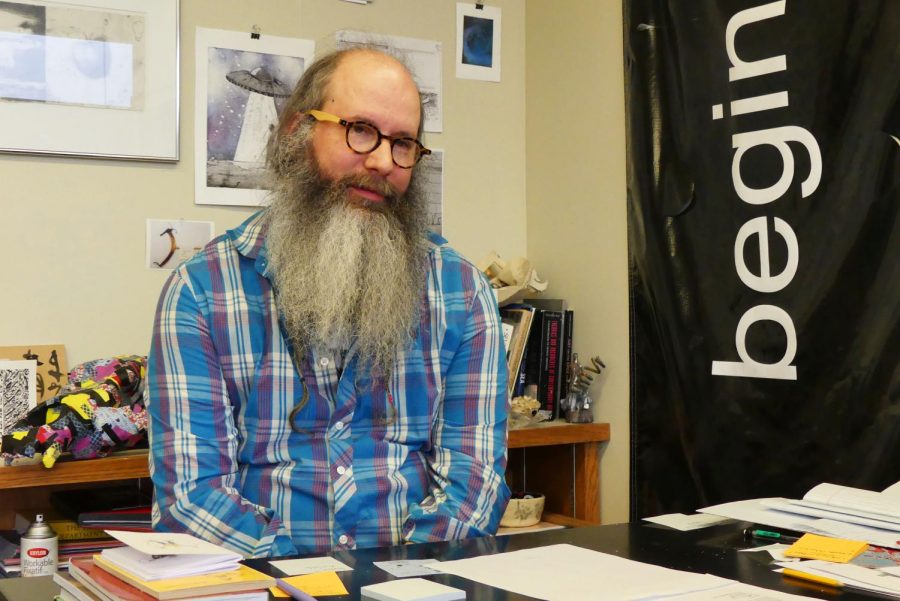Faculty artists present campus collection
Researchers presented findings at Cybersecurity Symposium, say it opened conversation
Squeak Meisel, WSU Fine Arts Department Chair and associate professor, says the exhibit featured work from more than 16 faculty and staff members from across the system. The styles of art ranged from drawing to large interactive electronic installations.
February 10, 2020
Washington State University, Tri-Cities, Clinical Assistant Professor of Fine Arts Sena Clara Creston displayed her interactive piece at the WSU faculty and staff exhibit last Friday on the Tri-Cities campus.
The exhibit opened Jan. 31 and will be on display until Feb. 28.
Fine Arts staff and faculty from all WSU campuses went to the opening on the Tri-Cities campus including WSU Fine Arts Department Chair and Associate Professor Squeak Meisel.
According to Meisel, the exhibits opening drew in over 136 people from the campus and community. The exhibit was made up of a collection of pieces from 16 different members of faculty and staff from all WSU campuses. The styles of art ranged from drawn art pieces to large interactive electronic installations.
Creston’s piece titled “Willow of the Waste” stood out as an electronic interactive art piece that conveys a statement about the environmental impact of plastic. Naturally, the installation is made up of plastic bottles she has been collecting over the last three years.
The juxtaposition of her early life in New York versus her life in eastern Washington served as an inspiration for the piece.
Creston was raised by two artists in New York City, she grew up surrounded by a strong art culture. In order to rebel from her art upbringing, Creston developed a love for math and science. By the time she took physics in high school she was set on becoming a physicist.
After deciding that solving the problems of the physics world was not where her heart was, Creston transferred to New York University to study art and imaging. Creston’s roommate, Heather Dewy-Hagborg, eventually introduced her to interactive pieces and electronic art installations.
“When I was a photographer, I wanted to make these images little worlds you could crawl into,” Creston said. “I wanted to show that these images were emotionally evocative and that’s when I got into installation.”
Her roommate gifted her the book, “Getting Started in Electronics” by Forrest Mims. Creston built up experience building electrical pieces. From there she pursued a job working for interactive installation artist Mark Esper.
Creston ended up working alongside Esper for three years without pay, which allowed her to study and learn alongside him. From there, she went on to graduate school at Rensselaer Polytechnic Institute (RPI) to further study interactive art installation. She learned from a mentor at RPI that she needed to collaborate to bring all her ideas to life. This advice went on to inspire collaborative work on pieces like “Willow of the Waste”.
“Willow of the Waste” has drawn attention as a statement on the impact of plastics on our planet. While this message is a central facet of the piece, for Creston the themes and meaning go much deeper. For her the installation encapsulates her desire to create a world that people can crawl into.
Creston explained that the choice of plastic bottles came from her search for a material that was both translucent and easy to work with.
She found plastic to be a viable translucent material that kept the LED lights’ integrity. Additionally, it sent a dual message of “things that are helpful, nurturing, enticing, things that we want. As well as things that are vengeful and destructive.”
According to Creston, the exhibit is a dark space, only illuminated by a lavender glow coming off a translucent tree.
The tree moves as if it were breathing in and out, and as you get closer the plastic tree transitions to a nervous in and out movement. When you travel even closer the branches violently snap their leaves open and shut. This is a representation of push and pull, which has become a common theme in many of her projects.
According to Creston, “Willow of the Waste” is part of two larger series titled “Plastic Garden” and “Machine Escape.” The latter of the two is currently in development, Creston describes it as a large collection of pieces that come together to form one living, breathing, interactive space.
For more information on Sena Clara Creston, go to http://www.senaclaracreston.com/ for more information. For more information on the WSU Tri-Cities Art Exhibit go to https://tricities.wsu.edu/art-center/.
















Forrest M Mims III • Feb 10, 2020 at 7:46 am
Delighted to know that my book “Getting Started in Electronics” played a role in Sena Clara Creston’s background.